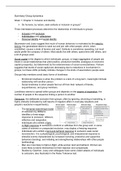Resume
Summary Group dynamics/Samenvatting Groepsdynamica
- Cours
- Établissement
- Book
With downloading, you will get a full summary of all literature of Forsyth's book for the course Group dynamics. It is compact, yet complete. For this exam you won't have to worry about missing important information!/Met het downloaden krijg je een volledige samenvatting van alle literatuur uit he...
[Montrer plus]




